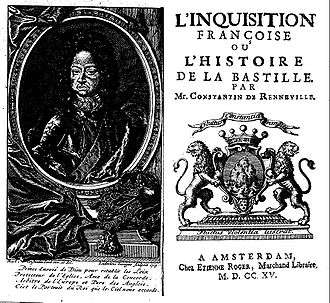Estienne Roger

Estienne Roger (1665 or 1666 in Caen, France – July 7, 1722 in Amsterdam) was a francophone printer and publisher working in the Netherlands.
Life
Roger was born a French Huguenot. The revocation of Edict of Nantes in 1685 made him flee with his family to the Netherlands where he settled in Amsterdam to learn the trade of a printer in the shop of Jean-Louis de Lorme. In 1691 he married Marie-Suzanne de Magneville (c. 1670–1712). In 1696 he opened his own shop.
Roger concentrated on histories, grammars, dictionaries, and eventually became a renowned publisher of musical scores. Between 1696 and 1722 he published over 500 editions of music written by a wide range of composers. In some cases, Roger offered mere reprints aiming at the European market he successfully reached (works that had been published by Giuseppe Sala in Venice or Ballard in Paris). His own publications were reprinted especially by Pierre Mortier in Amsterdam and John Walsh in London. Apart from "serious" music, or "classical" as it would be termed today, he also published popular music, such as his volumes of Oude en Nieuwe Hollantse Boerenlietjes en Contradansen, published 1700-1716.[1]
In 1711 he published Vivaldi's Opus 3 L'estro armonico, a collection of 12 concerti for one, two, and four violins with strings.[2]
Roger was famous for the taste and the diligence of his work and for his ability to sell large editions he would advertise in Western Europe. Trade connections to Rotterdam, Brussels, Liege, Paris, Cologne, Leipzig, Halle (Saale), Berlin, Hamburg and London ensured international outreach. His command of the European market was striking, with publication histories such as the one he could grant Constantin de Renneville's French Inquisition. The edition he sold in 1715 was reprinted in London and Nuremberg that very year, proof that his copies had reached readers in both cities within weeks.
In 1716 Roger's daughter Françoise (1694–1723) married the printer Michel-Charles Le Cène, who worked in the shop till 1720, the date he opened his own business. Roger's second daughter Jeanne (1701–1722) became his official heiress and acted as publisher on several occasions before 1722. She died only five months after her father.
Instead of passing the shop into the hands of her sister Françoise and her husband Le Cène, she left it to Gerrit Drinkman, a company employee who in turn died but a few months later. Le Cène was finally able to buy the shop and continued its main business, music, until his death in 1743 with more than 100 new publications. The shop ultimately ceased operation in 1748.
References
- ↑ Profile, jansmed.be; accessed 16 June 2015.
- ↑ Michael Talbot, Vivaldi (London: J.M. Dent & Sons, Ltd, 1978), p.42.
- Samuel F. Pogue and Rudolf A. Rasch: Art. "Roger, Estienne", in: The New Grove Dictionary of Music and Musicians, second edition, ed. by Stanley Sadie, London / New York 2001, vol. 21.